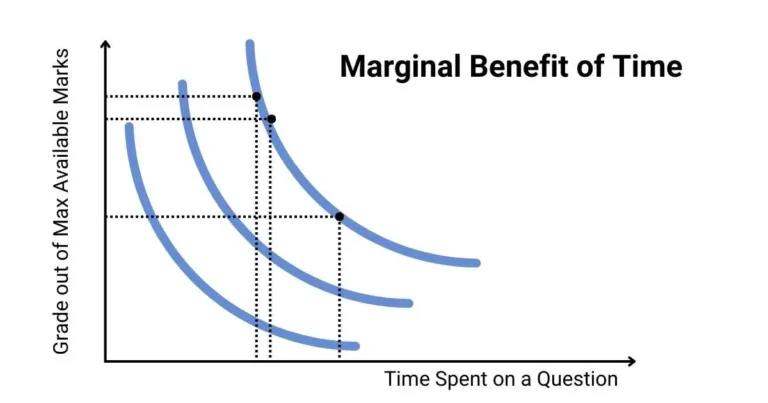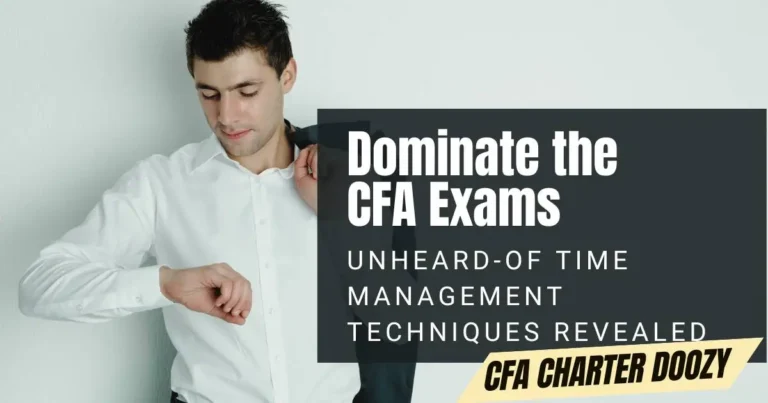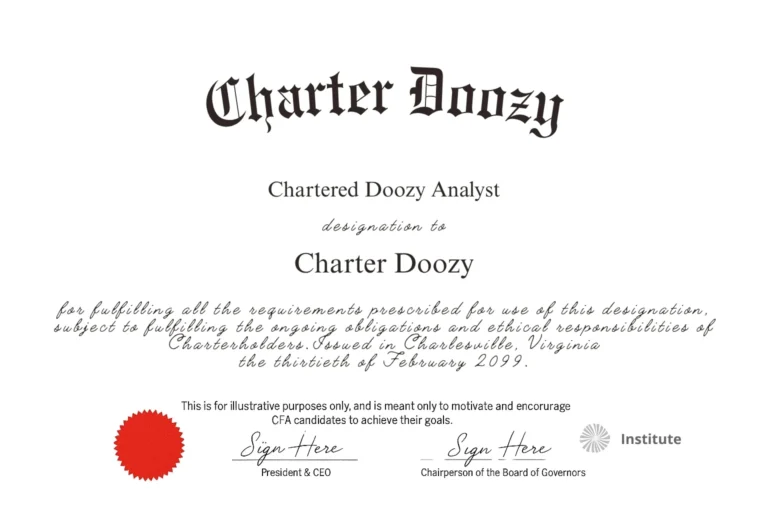Search any CFA discussion forum and you’re likely to find several threads on the problem of not having enough time finishing the exams.
While important and worth mentioning, the issue is that most advice out there is generic, and frankly quite obvious.
✔ Watch the Clock
✔ Get familiar with your CFA calculator
✔ Do your CFA practice exams under timed conditions.
✔ Use abbreviations in Constructed Responses (Level 3 Essays) such as PV for present value, and arrows to indicate up or down (↑ or ↓).
✔ Familiarize yourself with shortcuts and approximation techniques for complex calculations.
✔ Use all available time in the exam, and if you finish early, use the remaining time to review your answers to ensure you haven’t made any careless mistakes.
✔ Even better, avoid careless mistakes altogether by reading the question carefully
✔ Use a process of elimination to remove any obviously wrong answers on multiple choice questions.
But training yourself to complete the exam on time is on my list of top 5 most important skills to develop to pass the CFA exam.
Many candidates focus 99% of their study time and energy on the course material, but this is a fatal mistake.
We recommend aiming to complete the curriculum 6-8 weeks before the exam, leaving enough time to master the skill (yes, the skill) of writing a powerful exam within the time constraints.
In this article we dive deeper into the mindsets, techniques and strategies you’ve probably never considered before, but which can make all the difference on exam day.
If you’re looking for L3 advice specifically then read until the end.

Time Management Across the CFA Levels
In every CFA exam level time-management takes a different flavor.
I compare the CFA Level 1 exam to fast-twitch muscle fibers – short, powerful muscle contractions like those seen in explosive exercises such as sprinting, weightlifting, or box jumps.
You only get an average of 90 seconds per question (assuming no checks or reviews) in the L1 exam and you need to pound through these as quickly and accurately as possible.
The CFA Level 2 exam is more like slow-twitch muscle fibers – the muscle cells responsible for endurance movements like running a marathon.
L2 is where you have more time per question, but the vignettes that accompany the item-set questions can span multiple pages and take a long time to read and comprehend. So you’ll need to be much more deliberate and accurate, while still moving your a55.

And then, just when you think you’re getting the hang of it, the CFA Level 3 exam introduces the constructed response (essay) sets.
Here you will need to vomit everything you know onto the page, while demonstrating mastery of the material, and while hitting all the key points in the allocated time.
Doozy Digest
A newsletter for CFA candidates
Subscribe for:
✔ Insightful tips
✔ Expert advice
✔ Career motivation
✔ Exam inspiration
Stay updated and subscribe today!
80% on 100 is Greater Than 100% on 80
Fact: The CFA exams are designed to have time constraints.
Running short on time in a CFA exam is a feature not a bug.
We can debate the merits of this testing approach and how realistically (or not) it mimics the real world work of a financial analyst, but at the end of the day this is a reality.
You will not have enough time to write the perfect exam. There will not be enough time to deliberate fully on each question, weigh up the options, check each answer and review at the end.
Given this reality you have a choice.
You can either attempt only 80% of the questions to 100% perfection, or all 100% of the questions but only to an 80% standard.
Which is better – 100% on 80 marks or 80% on 100 marks?
The answer is the latter.
The reason for this is what I call the Marginal Benefit of Time. What this means is that for every additional minute of time one allocates to a question, the fewer marks one can obtain.
Think of a L2 or L3 item-set question. If you only had a minute or two you’d go for the easiest marks, the ‘low hanging fruit’. After that the medium difficulty questions, and the most challenging marks last. You’d eventually reach a point where no matter how much time you have you will not be able to score any extra marks, either because you have reached 100% for the item-set, or you simply don’t know how to answer the problem.
This means you at least want to spend a minimum amount of time on each and every question, at the point of highest marginal benefit.

Some people prefer to think about this concept in terms of ‘perfection’ rather than time.
Your ‘perfect’ attempt at a question is probably not perfect, and the little you could gain from being extra pedantic is more than made up by moving on and covering more ground.
In the CFA exam room, perfection is the enemy of good.
Let’s take the CFA Level 1 exam as an example.
There are 4.5 hours (270 minutes) to cover 180 questions, or an average of 90 seconds per question.
Now let’s imagine that your studies have prepared you so that you get 70% of answers correct. But, if you could spend an extra 20 seconds per question (110 seconds average speed) you could get this up to a 75% success rate.
Well, by speeding through at 90 seconds per question you will complete all 180 questions, and with an accuracy rate of 70% that’s 126 marks out of a possible 180. A 70% score (obviously), and a good chance of passing.
However, by slowing down, you now only cover 147 questions, and with an accuracy rate of 75% that’s 110 marks out of a possible 180. A lower final score of only 61%.
So if you are inclined to perfectionism this is something to bear in mind and improve.
If time is up on a question, choose/write an answer, and move on. Even if your perfectionist brain tells you to continue.
Shoot and go.
You might have gotten away with your pedantic ways at schools and university, but this will trip you up in the CFA Program.

Get Good at Guessing
Imagine this scenario.
You’ve studied and practiced really hard, but only half the curriculum.
For the other half you have only a passing familiarity with the material. Enough to spot some of the obviously wrong options in an MCQ (Multiple Choice Question) and to make some educated guesses, but not enough to actually get to the right answer.
If you can get 80% for half of the questions, and correctly guess at a 50% rate for the other half, congratulations you’ve probably just passed the exam.
This is not meant to be a hack to halve your study time, but a thought experiment to show the value of an educated guess.
Even if you don’t have the time, put something down. You can come back to it later if you have time.
There is no negative marking in CFA MCQ questions. Yet it’s amazing how many candidates will leave blank answers.
Writing something down in a Level 3 essay, such as showing your calculations or workings, can get you some marks, even if the final answer is hopelessly incorrect.
There is no shame in an educated guess or estimation.
A Point is Just a Point
In 2024 Roger Federer gave a Commencement Address at Dartmouth College.
Turning to the graduating class he asked: “What percentage of the points do you think I won in professional matches?
Only 54%.
In other words, even top-ranked tennis players win barely more than half of the points they play.
When you lose every second point, on average, you learn not to dwell on every shot.
You teach yourself to think: OK, I double-faulted. It’s only a point.
OK, I came to the net and I got passed again. It’s only a point.
Even a great shot, an overhead backhand smash that ends up on ESPN’s Top Ten Plays: that, too, is just a point.
Here’s why I am telling you this.
When you’re playing a point, it is the most important thing in the world.
But when it’s behind you, it’s behind you… This mindset is really crucial, because it frees you to fully commit to the next point… and the next one after that… with intensity, clarity and focus.”
This is a really critical mindset, in the CFA exam room as much as on the Wimbledon court.
Keep calm and carry on.
You are going to have some good questions and some absolute ball-breakers (excuse the pun).
No matter what happens, you need the mindset to focus on the question in front of you.
That next point.
Just chug on and finish it the best you can.
You’ll be amazed how smart, resilient and resourceful you are when you face up to these challenges.
Your mental game is key. Your choice of reaction will determine the outcome.
Always be thinking: what can you do to salvage the current situation for the best outcome?

You Don’t Have to Make It Back the Way You Lost It
Warren Buffet once famously said that you don’t have to make it back the way you lost it. This was a reminder to investors that they shouldn’t be fixated on recouping losses by following the same strategy or investment that caused the loss in the first place.
Emotional attachment to a past loss can inhibit flexibility and adaptability in investing. The pain of loss can break rational decision making, and stop you from looking for new opportunities that offer better potential for returns
The mentality holds in the CFA Exams. Instead of wasting time beating a dead horse, rather take a quick guess and move on. Use the time saved to score extra points where you know you can get them.
Chunking Technique
That’s enough on mindset, now let’s move on to some practical techniques and strategies.
The first is known as the ‘chunking technique’.
As the name suggests, with the chunking technique you break the exam into smaller, manageable sections or chunks to help maintain focus and ensure even time distribution across the exam. This can be based on a set number of questions or pre-defined time segments.
You then set checkpoints and milestones for each chunk to assess your progress throughout the exam.
As an example, in the CFA Level 2 exam you are given 12 minutes per item set (vignettes).
So you could set up your chucks and milestones as follows:
Thirty minutes: complete 2.5 item sets
One hour: complete 5 item sets
An hour and a half: 7.5 item sets
Two hours: 10 item sets
This provides a simple benchmark to work against, and a way of knowing if you’re still on track.
—
Another way to do this is to use ‘Time Budgeting’. This was a method which served me very very well as a candidate, and has proven helpful to many of the clients I’ve assisted over the use.
The key to this method is to set up an imaginary ‘Time Account’.
Then, for each question, you create a Time Budget. For example 1.5 minutes for a Level 1 MCQ, 12 minutes for a Level 2 vignettes, or 24 minutes for a Level 3 item set.
Now, as you go along, if you finish a question faster than the allocated time, you add to the Time Account.
You can think of this as saving (adding) time-tokens into your ‘piggy bank’, which you can then dip into later.
The opposite is also true for slower than expected responses, where you expend time-tokens from the Time Account.
You keep a running tally of these ‘overs’ and ‘unders’ as you go along. This approach is quick and can become second nature if practiced beforehand.
The Time Account will keep you consistently focussed on the key constraint in a CFA Exam – time.
When you come across some easier questions, you’ll look to shave off a few seconds so that you have more time for those which require more thought, calculation, or deliberation.
Conversely, when you encounter a more difficult question, you’ll be able to make a deliberate decision to trade-off to use some banked time where you know this will yield the most points.
You’ll be like an accountant with a budget, thinking how best to allocate each dime (each minute) in order to get the best return (score the most marks).

Level 3 Essay Questions
The L3 constructed response (essay) questions are unique in the CFA exam experience. This section is devoted specifically to time management advice for this section of the CFA Program.
The first thing to mention is that you’ll need to establish and hone your own approach to constructed response questions. Typical essay questions will include significant amounts of case information and background reading. This is needed to answer the accompanying questions.
Many candidates begin directly with the case information. A better approach is to first read the questions. You might not have the full context, but when you then read the case material you’ll have a better sense of what you’re looking for. This will bring structure and focus to your reading.
Your mind will concentrate on what is most important and will begin formulating responses as you read. This active reading is more time efficient than reading and re-reading the content again.
A good rule of thumb is to spend more than half the time reading, thinking, and deciding. Less than half the assigned time is actually needed for writing out the answers.
Think first, then type!
—
With regards to the actual writing itself, you should develop a writing style which supports your goal of hitting as many points as possible in the available time.
Do not answer in essay form. This is a waste of time.
The essay format is not only inefficient, but is also ineffective. A dense paragraph may contain 4-5 separate point answers, but the format can make it difficult for a CFA grader to untangle the separate points.
You don’t want to leave it to chance that the person grading your essay finds all the relevant points.
Keep your answers short yet understandable.
We recommend using bullet points (in the current computer-based exams, using the hyphen (“-”) sign is fine as a bullet point). Remember, answers are graded only on content, not on language or style.
Bullet points are the most efficient, legible, concise, and direct way to say what you need. Bullets will also keep your answers short yet understandable. They will also help guide the grader and make it easy for them to award you marks.
By making sure that each bullet gets across a distinct and clear point, you’ll avoid rambling and wasting time repeating yourself.
If a question asks for 1 advantage or 2 reasons, provide no more than the number of advantages or reasons requested. Only the first advantage and the first two reasons that you provide will be graded, so there is no point writing more.

Practice Makes Perfect
The last thing to say on the topic of exam time management is that it requires practice.
I don’t use the term ‘topic’ lightly. I quite literally think of time-management and exam technique the same way I think about ethics, economics, derivatives and equities. These are core skills which need to be mastered in order to pass.
And by the way, this is more than just practicing a few mock exams under timed conditions.
You need to develop a technique and style that works for you. You must have this skill honed, drilled and rehearsed before the big day.
There will be a lot of nerves and distractions at the exam venue. Unless you have your technique well rehearsed beforehand, it will not stick.
Final Thoughts
To sum things up, you need to face the reality that time is a constraint in CFA exams. And you need to face this head-on and prepare accordingly.
You’re welcome to use any of the strategies mentioned above, or to create your own.
But you do need a strategy.
Coming out of the exam room saying you unexpectedly ran out of time is no excuse.
It’s an absolute rookie error.
I’m sorry to say it, but if that’s you, you deserve the fail that’s inevitably coming your way.
Harsh but true.

